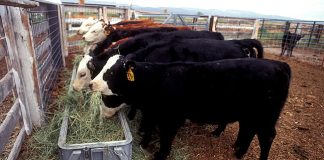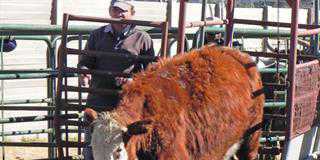Phoshate and trace mineral deficiencies have also been reported. Discuss nutritional requirements and programmes for your animals with the relevant experts.
- State and private vets and farmers need to work together to control brucellosis as this zoonotic disease is getting out of hand. Vaccination should be done according to law, strict biosecurity measures should be in place, animals tested and cattle movement controlled.
- Now is the time to do pregnancy examinations to decide which unproductive animals should be sold.
- Also, to prevent heavy brown ear-tick burdens in the summer the inner ear of cattle must be examined for immature ticks and treated if necessary.
- May usually has low temperatures with frost, but in many parts of the country day-time temperatures were higher than 25°C and, with late autumn rains, parasites were still abundant.
There were reports of heavy wireworm infestations along with anthelmintic resistance. Livestock was put in vleis where the infective stages of liver fluke and conical fluke were abundant. Animals should be regularly examined for signs of parasites and treated in time to prevent production losses.
- Unexpected outbreaks of blue ticks were reported from some areas and, as a result, Asiatic and African red water followed. Many cases of anaplasmosis were also reported. Discuss your vaccination programme against tick-transmitted diseases with your vet.
- Venereal diseases (trichomonosis and vibriosis) continue to be reported every month. Stringent biosecurity measures should be in place and bulls tested for these diseases. Farmers need to work with their vets to eradicate these diseases which cause immense economical losses.
- Although a few cases of insect-transmitted diseases (lumpyskin, bluetongue, three-day stiff sickness) were reported, these are limited in autumn and winter. This is the time to order vaccines and to plan when animals are to be vaccinated to prevent outbreaks in summer.
- Bovine malignant catarrh (snotsiekte) outbreaks were reported from many areas. Farmers should be aware of the carriers (blue and black wildebeest and sheep) of the virus causing this disease as there’s no vaccine or treatment available.
- Bovine viral diarrhoea and enzootic bovine leucosis, which suppress the immunity of cattle, were reported. Discuss these diseases with your vet as they lead to production losses.
- With big fluctuations between day and night temperatures, pneumonia in sheep and cattle, as well as resulting fatalities, were reported from most areas. Pneumonia can be prevented with a vaccination programme – discuss the various available vaccines with your vet.
- The following poisonings occurred: urea, tulip, Lantana, Cestrum (ink berry), prussic acid, acidosis and Vitamin B1 deficiency (CCN), excessive protein on soya-harvested fields, mycotoxins-contaminated hay and silage, bloat on clover pastures.
Feedlot report
Cattle
- The usual occurrence of pneumonia during May is caused by calves not yet adapted to the cold and sudden cold spells and great variation between day and night temperatures.
- Newly weaned calves (wet calves) are stressed and are more susceptible to pneumonia. Lean calves usually die first since they have no fat reserves.
- Some calves arrive with lung lesions and usually die within the first week after arrival.
- Internal and external parasites are still rife and have a negative effect on animal’s resistance.
- Gasgangrene caused by Clostridium novyi type A occurred in cows and calves on veld after vaccination with a vaccine that did not contain this antigen.
Sheep
- Outbreaks of pneumonia occurred due to dusty conditions and weather changes.
- A huge outbreak of Salmonella Typhimurium occurred, causing mortalities. The sheep were also infested with bankrupt worm when they arrived at the feedlot.
- Some groups of sheep arriving at feedlots are heavily infested with internal parasites.
Click on the link for a more detailed report – Disease Trends Map













